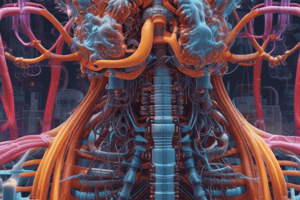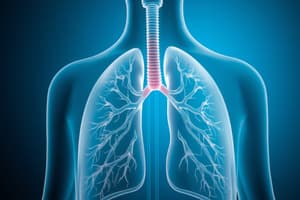Podcast
Questions and Answers
What is the term used to describe sex cells that contain a single set of chromosomes?
What is the term used to describe sex cells that contain a single set of chromosomes?
- Homologous
- Haploid (correct)
- Polyploid
- Diploid
Which of the following disorders is an X-linked recessive disorder?
Which of the following disorders is an X-linked recessive disorder?
- Duchenne Muscular Dystrophy (correct)
- Sickle Cell Anemia
- Down Syndrome
- Cystic Fibrosis
Hypertrichosis pinnae Auris, a condition characterized by hairy ears, is passed from father to son. This characteristic is an example of which type of gene linkage?
Hypertrichosis pinnae Auris, a condition characterized by hairy ears, is passed from father to son. This characteristic is an example of which type of gene linkage?
- X-linked
- Autosomal dominant
- Y-linked (correct)
- Autosomal recessive
Which of the following traits are expressed exclusively in one gender due to their genetic expression?
Which of the following traits are expressed exclusively in one gender due to their genetic expression?
What distinguishes sex-influenced traits from sex-linked traits?
What distinguishes sex-influenced traits from sex-linked traits?
What is the primary role of the diaphragm during inhalation?
What is the primary role of the diaphragm during inhalation?
Which chamber of the heart is responsible for pumping oxygenated blood to the body?
Which chamber of the heart is responsible for pumping oxygenated blood to the body?
What is the primary component that makes up about 55 percent of the total volume of blood?
What is the primary component that makes up about 55 percent of the total volume of blood?
What vessels carry deoxygenated blood back towards the heart?
What vessels carry deoxygenated blood back towards the heart?
What is the main function of capillaries in the circulatory system?
What is the main function of capillaries in the circulatory system?
What role does plasma play in blood circulation?
What role does plasma play in blood circulation?
Which type of circulation occurs between the heart and the lungs?
Which type of circulation occurs between the heart and the lungs?
What is the significance of the septum in the heart?
What is the significance of the septum in the heart?
What is the primary function of the lungs in the respiratory system?
What is the primary function of the lungs in the respiratory system?
Which structure is known as the 'voice box' and contains the vocal cords?
Which structure is known as the 'voice box' and contains the vocal cords?
What role do the cilia in the nostrils serve in the respiratory process?
What role do the cilia in the nostrils serve in the respiratory process?
During which process does the diaphragm contract and move downward?
During which process does the diaphragm contract and move downward?
What is the pathway for air entering the respiratory system?
What is the pathway for air entering the respiratory system?
Which part of the respiratory system prevents food and liquids from entering the trachea?
Which part of the respiratory system prevents food and liquids from entering the trachea?
What happens to the air inside the lungs during exhalation?
What happens to the air inside the lungs during exhalation?
Which structure is responsible for the majority of gas exchange in the lungs?
Which structure is responsible for the majority of gas exchange in the lungs?
What is the primary function of systemic circulation?
What is the primary function of systemic circulation?
Which is a characteristic of a homozygous individual?
Which is a characteristic of a homozygous individual?
What are the smallest blood vessels that facilitate the exchange of oxygen and nutrients?
What are the smallest blood vessels that facilitate the exchange of oxygen and nutrients?
What role does the diaphragm play in the respiratory system?
What role does the diaphragm play in the respiratory system?
Which of the following statements about blood vessels is true?
Which of the following statements about blood vessels is true?
What is the composition of DNA?
What is the composition of DNA?
Which type of chromosome is referred to as an autosome?
Which type of chromosome is referred to as an autosome?
What defines a diploid organism?
What defines a diploid organism?
Flashcards are hidden until you start studying
Study Notes
Breathing Process
- Breathing delivers oxygen to the body and removes carbon dioxide; essential for animal life.
- Land animals obtain oxygen from the air via the nose or mouth.
- The nasal cavity contains cilia that filter air for impurities.
Respiratory Pathway
- The pharynx serves as a passage for both food and air, part of the respiratory and digestive systems.
- The larynx acts as the voice box, housing vocal cords; the epiglottis prevents food from entering the airways.
- The trachea (windpipe) transports air, is reinforced by cartilage, and splits into bronchi leading to bronchioles.
Gas Exchange
- Alveoli are air sacs in the lungs where gas exchange occurs; they facilitate oxygen absorption into the bloodstream.
- Lungs consist of bronchioles, alveoli, blood vessels, and elastic tissue; crucial for respiration.
- Inhalation occurs when the diaphragm contracts, expanding chest cavity and drawing air in.
Circulatory System Function
- Transports oxygen and nutrients to cells and returns deoxygenated blood to the heart and lungs for reoxygenation.
- Major components include the heart, blood, and blood vessels.
- Blood circulates through the body approximately every 60 seconds.
Blood Components
- Blood plasma, making up 55% of blood volume, is a straw-colored fluid.
- Red blood cells carry oxygen; white blood cells and platelets have different functions.
Blood Vessels
- Arteries transport oxygen-rich blood away from the heart, except for pulmonary arteries carrying deoxygenated blood to lungs.
- Veins return oxygen-poor blood to the heart; pulmonary veins carry oxygenated blood from lungs.
- Capillaries are the smallest vessels, facilitating nutrient and waste exchange at the cellular level.
Heart Structure
- The heart comprises four chambers: right atrium, left atrium, right ventricle, and left ventricle.
- The septum separates the ventricles, preventing mixing of oxygenated and deoxygenated blood.
Circulatory Pathways
- Pulmonary circulation: between heart and lungs.
- Systemic circulation: between heart and body, excluding lungs.
- Coronary circulation: blood vessels supplying the heart muscle itself.
Genetics Overview
- Genes are sections of chromosomes determining characteristics like skin color and height.
- DNA consists of nucleotides with nitrogenous bases: adenine, guanine, cytosine, and thymine.
Genetic Terminology
- Homozygous: individual with two identical gene forms; influences true breeding traits.
- Heterozygous: individual with different gene forms from each parent.
- Autosomes: non-sex chromosomes present in both sexes; sex chromosomes determine gender differences.
Chromosome Types
- Diploid: cells with paired chromosomes (23 pairs in humans), includes all non-sex cells.
- Haploid: sex cells (egg and sperm) with a single chromosome set.
Sex-linked Traits
- Traits located on X or Y chromosomes exhibit phenotypic expression based on chromosomal sex.
- X-linked recessive disorders include color blindness and hemophilia, among others.
- Y-linked disorders transmitted exclusively from father to son, such as hypertrichosis auris.
Special Genetic Traits
- Sex-limited traits are autosomal, expressed in only one sex, while sex-influenced traits express differently in males and females.
Studying That Suits You
Use AI to generate personalized quizzes and flashcards to suit your learning preferences.




